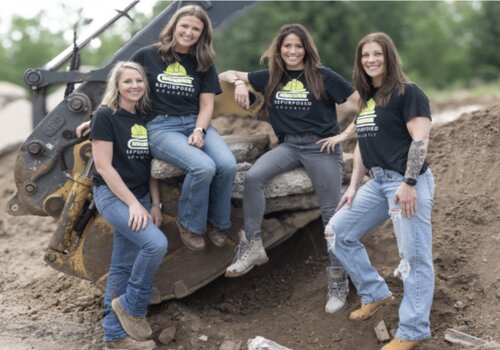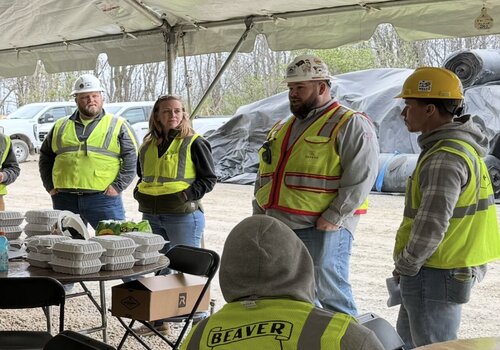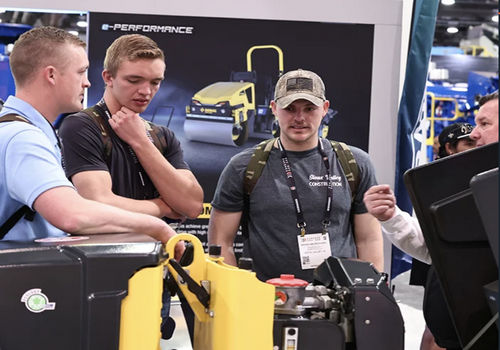Succession planning is a critical aspect of maintaining the longevity and success of any business, especially in industries like construction, where leadership transitions can significantly impact company culture and operations. Chelsea A. Ellis-Hogan, a third-generation co-owner of Jim Reynolds Asphalt Contractor who is currently succession planning right now, shares her insights on how to navigate this complex process effectively, ensuring that a company continues to thrive through the generations.
THE IMPORTANCE OF SUCCESSION PLANNING
Even if a leadership shift isn’t imminent, it’s essential to have a succession plan in place. As Ellis-Hogan puts it, “It helps your leadership figure out where their expertise will be most beneficial within the company as they eventually transition.” This planning also allows leaders to feel involved in the process, making the transition feel more natural and less forced.
Having a plan in place also prepares a company for unexpected events that could force a change in leadership. “You never know when the time will come,” Ellis-Hogan says, emphasizing the importance of readiness. “Having something in place helps so you don’t feel like you’re rushing when the moment arrives.”
PLANNING YOUR OWN TRANSITION
Ellis-Hogan, who is also an entrepreneur and author, has thought about her own succession, highlighting the importance of attitude. “One of the biggest things I’ve thought of is just mindset,” she explains. Entrepreneurs are inherently driven to stay productive and involved, but there comes a time when the focus must shift. For Ellis-Hogan, preparing for this transition involves continuous learning—reading books, listening to podcasts and staying open to new ideas.
She also believes in preparing others within the company for future leadership roles. “It’s important to let people know that there’s going to be room for them in these positions one day,” she says. This proactive approach to succession planning not only fosters a strong leadership pipeline but also encourages current leaders to stay engaged and contribute to the company’s long-term vision.
OVERCOMING CHALLENGES
Leadership transitions, especially across generations, come with their own set of challenges. One of the most significant, according to Ellis-Hogan, is the mentality shift required from the outgoing leadership. “A lot of people know that change needs to happen, but it’s scary when that time comes,” she says. Overcoming this fear requires clear communication and setting up a plan that makes everyone involved feel comfortable.
Communication is also key when it comes to informing the rest of the company about changes in leadership. “It’s important that the workforce understands what’s going on,” Ellis-Hogan advises. This transparency helps maintain trust and ensures that everyone is aligned with the company’s future goals.
The size of a company can influence how it approaches succession planning. Smaller businesses might have the flexibility to “build the plane as they go,” while larger companies often need to implement more structured resources, such as software systems or external consultants. “The differences come into play in how you navigate the process, the time you invest and the financial commitment,” Ellis-Hogan notes.
Technology plays a crucial role in modern succession planning. Ellis-Hogan recommends starting with the basics: a CRM system to track customer data, a bookkeeping and invoicing system for financial management, and scheduling and tracking systems to streamline operations. “Technology can take a lot off the leadership’s plate, making succession planning more manageable,” she says.
Having something in place helps so you don’t feel like you’re rushing when the moment arrives.
Chelsea A. Ellis-Hogan
Third-generation co-owner of Jim Reynolds Asphalt Contractor
KEEPING THE COMPANY CULTURE INTACT
One of the biggest concerns during a leadership transition is maintaining the company culture. For Ellis-Hogan, this involves continuous education and training, which she believes are vital for empowering staff and leadership. Her company hosts an annual retreat focused on personal development, workforce development and leadership growth. “That’s been a major part in our growth and keeping the culture alive,” she says.
Safety and mental health are also priorities in her company’s culture. By focusing on these aspects, Ellis-Hogan ensures that her team is not only skilled and knowledgeable but also healthy and motivated to contribute to the company’s success.
ESSENTIAL SKILLS FOR EMERGING LEADERS
For those aspiring to leadership positions in the construction industry, Ellis-Hogan emphasizes the importance of critical thinking, problem-solving and communication. “Every job site and project is a little different, so being able to deal with changes and adapt is very important,” she says. Good communication, whether with other leaders, the workforce or customers, is also crucial for smooth operations and effective leadership.
THE FAMILY LEGACY: A PERSONAL STORY
Ellis-Hogan’s journey to leadership was shaped by her family’s legacy in the construction industry. As the third generation to take on the company, she had the unique experience of transitioning into ownership while preserving the family’s business values. “We always knew it was going to happen eventually, but the timing was difficult to predict,” she recalls.
With three older brothers, one older sister and one younger brother, Ellis-Hogan was the only sibling who wanted to take over the family business from her father. Having worked alongside her father for years gave her the experience she needed, along with a passion to preserve her family’s legacy.
“It naturally flowed, and it allowed the legacy to stay alive,” she says, adding that being a woman taking over the family business “definitely shows that things are changing.”
Ellis-Hogan transition was made smoother by the company’s focus on core values, which helped attract and retain the right talent. “Since I started in ownership, we’ve had the same crew ever since,” she says proudly. This stability has been key to the company’s continued success.
As co-owner for four years with her father, Ellis-Hogan is now in the process of transitioning into full owner as her father prepares for retirement. This time can be both exciting and challenging for both the person leaving the incoming leader, even when it is a father-daughter transition.
“So, seeing it now happen and come into reality definitely was something that he's been very proud of – and then also I can say he's been very nervous as well.”
ADVICE TO OTHERS
Ellis-Hogan advises companies to document their processes thoroughly. “It makes it easier for future planners,” she says, noting that the likelihood of a business successfully transitioning through multiple generations increases with proper documentation.
When it comes to the outgoing leadership, Ellis-Hogan suggests keeping them involved, perhaps on an advisory board. “They hold the confidence of 30 to 40 years in the industry,” she says, emphasizing the value of their wisdom and experience. However, it’s also important to allow new leaders to make the company their own while still benefiting from the guidance of past leadership.
LOOKING TO THE FUTURE
As Ellis-Hogan navigates her own leadership journey, she remains committed to fostering the next generation of leaders within her company. She’s also passionate about inspiring others, particularly women and minorities, to pursue careers in construction. Through partnerships with local programs and organizations, Ellis-Hogan is working to ensure that the construction industry becomes more inclusive and diverse.
She is also thinking of the future and who may take over when she is ready to retire. She has a step-son, nieces and nephews who the family all try to imagine where they could fit into the company when they are older.
“We allow them to be involved in projects that we have to see what we're really doing behind the scenes,” she says. “We definitely try to get them involved any way we can, you know, based off of their age, and hope that they'll want to be a part of it one day. But you never know.”
Working alongside family and knowing that her father will be around in an advisory role is important for Ellis-Hogan, who is excited for the future.
“The ability of being able to build a legacy for your family, I definitely wanted to preserve that.”
Stay tuned as we explore Workforce Development topics this summer. Your journey to a safer, more productive work environment begins here, with CONEXPO-CON/AGG 365. Be sure to subscribe to the newsletter here so you don’t miss any news.
Photo credit: MICHAELJUNG/BIGSTOCKPHOTO.COM












